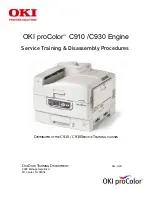
4
English
Changes or modifications not expressly approved by Oki Data may
void your authority to operate this device.
230/240-Volt Models
WARNING: This equipment has been tested and found to comply
with the limits for a Class A digital device, pursuant to Part 15 of
the FCC rules. These limits are designed to provide reasonable
protection against harmful interference in a commercial
environment. This equipment generates, uses and can radiate radio
frequency energy and, if not installed and used in accordance with
the instructions, may cause harmful interference to radio
communications. Operation of this equipment in a residential area
is likely to cause harmful interference in which case the user will be
required to correct the interference at their own expense.
Note:
It is the responsibility of the user to obtain the required
shielded cable in order to ensure compliance of this
equipment with FCC regulations.
Changes or modifications not expressly approved by Oki Data may
void your authority to operate this device.
Industry Canada (IC) Radio Interference
Statements
120-Volt Models
This Oki Data apparatus complies with the Class B limits for radio
interference as specified in the IC Radio Interference Regulations.
230/240-Volt Models
This Oki Data apparatus complies with the Class A limits for radio
interference as specified in the IC Radio Interference Regulations.
European Union Council of the European
Communities Statements of Conformance
for 230/240-Volt Models
Electromagnetic Conformance
This product complies with the requirements of the Council
Directive 89/336/EEC on the approximation of the laws of the
member states relating to electromagnetic compatibility.
Safety Conformance
This product is in conformity with Directive 73/23/EEC on the
harmonization of the laws of Member States relating to electrical
equipment designed for use within certain voltage limits.
Safety Information
Your OKI printer has been carefully designed to give you years of
safe, reliable performance. As with all electrical equipment, there
are a few basic precautions you should take to avoid hurting
yourself or damaging the printer.
• Carefully read the provided setup and operating instructions.
• Save all provided documentation for future reference.
• Read and follow all warning and instruction labels on the printer
itself.
• Unplug the printer before you clean it. Use only a damp cloth; do
not use liquid or aerosol cleaners.
• Place your printer on a firm, solid surface. If you put it on
something unsteady, it may fall and be damaged. If you place it
on a soft surface, such as a rug, sofa, or cushion, the vents may be
blocked, causing the printer to overheat.
• Protect your printer from overheating. Make sure no obstructions
block the openings of the printer. Do not put the printer on or
near a heat source (such as a radiator or heat register). Keep the
printer out of direct sunlight. Allow enough room around the
printer for adequate ventilation and easy access to the paper trays.
If you put the printer in any kind of enclosure, make sure the
enclosure is properly ventilated.
• Do not use your printer near water. Do not spill liquid of any kind
into it.
• Be certain that your power source matches the rating listed on the
back of the printer. If you are not sure, check with your dealer or
with your local power company.
• Your printer has a grounded, three-prong plug as a safety feature.
This plug only fits into a grounded outlet. If the plug does not fit,
the outlet may be an older, non-grounded type. Contact an
electrician to have the outlet replaced. Do not use an adapter to
defeat the grounding.
• Install the printer near an easily accessed power outlet.
• Avoid damaging the power cord. Do not put anything on it or
place it where it will be walked on. If the cord becomes damaged
or frayed, replace it immediately.
• If you are using an extension cord or power strip with the printer,
make sure that the total of the amperes required by all the
equipment on the extension is less than the extension’s rating.
The total ratings of all equipment plugged into the outlet should
not exceed 15 amperes.
• Do not poke anything into the ventilation slots of the printer. You
could get an electrical shock or cause hazardous electrical arcing,
which could cause a fire.
• Aside from the routine maintenance described in the
documentation, do not try to service the printer yourself.
Removing the cover may expose you to shocks or other hazards.
• Do not make any adjustments other than those outlined in the
documentation. You may cause damage that will require
extensive repair work. The provided documentation explains how
to get your printer serviced by qualified Oki Data technicians.
If anything happens that indicates that your printer is not working
properly or has been damaged, unplug it immediately and follow
the procedures in the provided documentation for having your
printer serviced.
Here are some of the things to look for.
• The power cord or plug is frayed or damaged.
• Liquid has been spilled into the printer, or the printer has been
exposed to water.
• The printer has been dropped, or the cabinet is damaged.
• The printer does not function normally when you are following
the operating instructions.





































